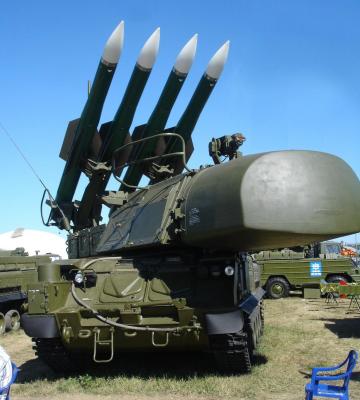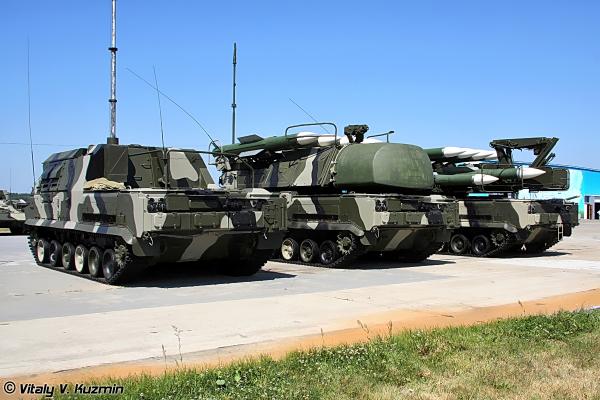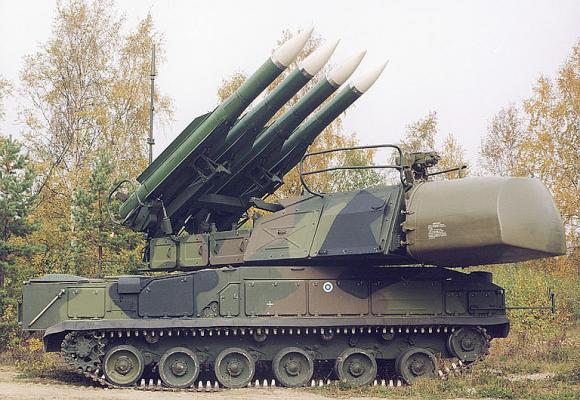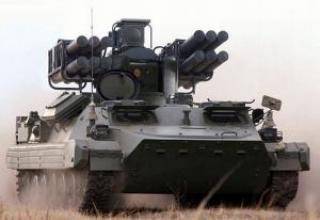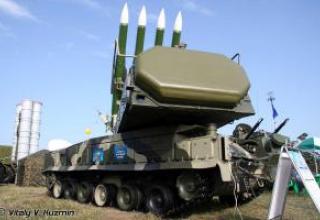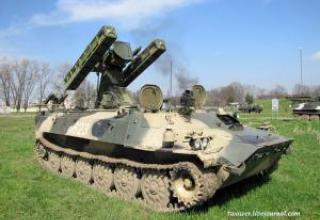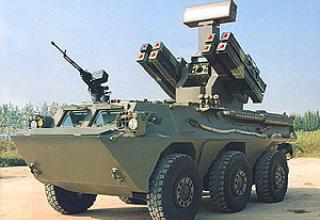In 1994-1997 the cooperation of enterprises headed by "V.V. Tikhonravov Scientific Research Institute" carried out work on creation of the modernized complex "Buk-M1-2" on the basis of 9K37 "Buk" SAMs. At the same time the complex turned into a universal firearm.
Due to application of the new 9M317 missile and modernization of other facilities of the complex for the first time it was possible to engage tactical Lance type ballistic missiles, aircraft missiles at ranges up to 20 km, precision weapon elements, surface ships at ranges up to 25 km and ground targets (aircraft at airfields, launchers, large command posts) at ranges up to 15 km. The effectiveness of aircraft, helicopters and cruise missiles has been improved. Defeat zone boundaries have been increased to 45 km in range and 25 km in altitude.
The uniqueness of the complex "Buk" and all its modifications is that with a significant size of the kill zone at a range, altitude and parameter of the combat mission can be performed by an autonomous use of only one land-based fire vehicle - a self-propelled gun. This quality makes it possible to ensure the sudden firing of air targets from ambushes, autonomous change of combat position, which significantly increases the survivability of the unit.
At present the developers offer a new variant of the family, which received the designation "Buk-M2".
Composition:
Complex "Buk-M1-2" differs from its predecessor "Buk-M1" primarily by using a new missile 9M317 (see photo). In addition to the application of the improved missile provides for the introduction of a new tool in the complex - radar target illumination and guidance missiles with the placement of the antenna in the working position at an altitude of 22 m using a telescopic device (see photo).
With the introduction of the target illumination and pointing radar, the combat capabilities of the complex to engage low-flying targets, in particular, modern cruise missiles are significantly expanded.
The composition of the complex :
- command post 9C470M1-2 (see photos 1, 2, 3, 4, 5)
- Six 9A310M1-2 self-propelled fires (see photo)
- three 9A39M1 starting chargers (see photo)
- target detection station 9C18M1 (see photo)
- maintenance machine (MTO) 9B881M1-2 with trailer ZIP 9T456
- maintenance workshop (MTO) AGZ-M1
- repair and maintenance (MRI) machines:
- MRTO-1 9B883M1
- MRTO-2 9B884M1
- MRTO-3 9B894M1
- 9T243 transport machine with a set of technological equipment (KTO) 9T3184
- Automated monitoring and testing mobile station (AKIPS) 9В95М1
- rocket repair shop 9T458
- unified compressor station UKS-400V
- mobile power plant PES-100-T/400-AKR1 (see photo).
The complex is offered in two variants - mobile on tracked vehicles of GM-569 family according to the type used in previous modifications of "Buk" complex, as well as transported on road trains with KrAZ semi-trailers and trucks. In the latter variant with some decrease in cost the cross-country ability indexes are worsening and the time of SAM deployment from the march increases from 5 to 10-15 minutes.
The self-propelled fire unit 9A310M1-2 is a part of it:
- radar station
- quadruple rocket launcher
- digital computer system,
- television optical vizier,
- laser rangefinder,
- navigation and communication equipment,
- "your own is a stranger" radio enquirer,
- a built-in simulator,
- documentation equipment.
Position of the radar and PU with missiles on the same rigid platform allows with the help of electrohydraulic drive their simultaneous azimuth rotation with lifting and lowering of the art part. In the process of combat work JMA carries out detection, identification, auto-support and recognition of target type, development of the flight mission, the solution of the launch task, the launch of the missile, target illumination and transfer of radiocorrection commands to the missile, assessment of the firing results. The JMA can fire targets as part of an anti-aircraft missile system at target designation from the command post, or independently in a predetermined sector of responsibility. Targets can be fired either from the JMA itself or from a booster attached to it (ROM).
The 9A310M1-2 JMA can be equipped with either the 9M38M1 standard missile or the newly developed 9M317 missile.
The anti-aircraft guided missile 9M317 was developed as a single missile for air defense of land forces and naval air defense ships (SAM "Hedge"). It affects tactical ballistic missiles, strategic and tactical aircraft, including maneuvering with an overload of 12 units., cruise missiles, helicopter fire support (including hovering at low altitudes), remotely piloted aircraft, anti-ship missiles in conditions of intense radio interaction, as well as radio-contrast surface and ground targets.
Compared to the 9M38M1, the 9M317 missile has an extended range of up to 45 km in terms of range and 25 km in terms of altitude and parameter, as well as a large nomenclature of targets to be hit.
Externally, differs from the 9M38M1 significantly shorter wing chord length, it provides for the use of inertial-corrected control system with a semi-active radar SNS 9B-1103M with guidance by the method of proportional navigation.
The technical solutions incorporated in it, based on the recognition results, allowed to adapt the control system and combat equipment of the missile to the type of target (ballistic target, aerodynamic target, helicopter, small target, surface (ground) target) and increase the probability of hitting. Due to the technical solutions implemented in the missile's onboard equipment and facilities of the complex, it is ensured that radio-contrast surface and ground targets are fired at and hit by direct hit. The missile can hit targets flying at extremely low altitudes. The range of target acquisition with EPR = 5 m² is 40 km.
A fully assembled and equipped missile is explosion-proof and requires no checks or adjustments during its lifetime. The missile has a high level of reliability. Its service life is 10 years and can be extended after special operations.
The high efficiency, versatility and possibility of using 9M317 SAMs has been confirmed during military exercises and firing.
The concealment of the SAM has been improved through the introduction of a laser rangefinder, which paired with a television optical sight, provides passive direction finding for ground (NZTs) and surface (NVC) targets. The revised software of the digital computer system provides optimal angles of the missile's flight to the target, at which the influence of the underlying surface on the missile's homing head is minimized. To increase the effectiveness of the missile's warhead when working on surface (ground) targets, the radio detonator is disabled and a contact fuse is connected. To improve the interference immunity of the complex introduced a new mode - "coordinate support". In this mode, to shoot at the operator of active interference is used range coordinate from other means of the complex. Thus, compared to the previously used mode of "Triangulation", which involved two JMA, the number of firing channels for the operator of active interference is doubled.
SOU 9A310M1-2 can be connected with the "Cube" complex. In this case, the "Cube" complex can simultaneously fire two targets instead of one. One target channel is SOU 9A310M1-2 with a self-propelled launcher (SPS) 2P25, the second - the standard, that is, the station control intelligence and guidance (SURN) 1C91 with SPS 2P25.
In recent years, the Instrument Engineering Research Institute and related organizations have successfully completed a number of research and development works on further modernization of the anti-aircraft missile system as a whole and its individual elements.
Main modernization directions:
- Increasing the number of simultaneously fired targets through the use of a phased array antenna (PHAR);
- improved noise immunity by adapting the VAR beam to tactical and interference conditions.
- increase of radar efficiency by increasing the transmitter power and microwave receiver sensitivity (new electronic devices);
- application of fast computers and modern digital signal processing.
Modernized SOU with PHAR can be associated with the means of complex "BUK-M1-2", so the number of simultaneously fired on his targets can be increased from 6 to 10 - 12.
Characteristics:
| Defeat zone, km: - at a distance - in height - as defined in |
till 45 till 25 till 25 |
| Rocket length, mm | 5500 |
| Rocket body diameter, mm | 400 |
| Wingspan,mm | 860 |
| Launch mass of the rocket 9M317, kg | 710-720 |
| Weight of combat unit, kg | 50-70 |
| Maximum available overload | 24g |
| Maximum target speed, m/sec. | 1200 |
| Deployment time (closures), mines | 5 |
| The number of SSDs on a combat vehicle | 4 |
Testing:
Joint testing of the complex "Buk" in the full set of funds were carried out from November 1977 to March 1979 at the Emba range (range manager V.V. Zubarev) under the guidance of a commission headed by Yu.
The command post of the complex received from the control of the anti-aircraft missile 6pigadas "Buk" (ACS "Polyana-D4") and from the detection and target designation station information about the air situation, processed it and issued to the self-propelled firing systems, which carried out search and seizure of targets on auto tracking. When a target entered the area of engagement, the SUR was launched. Missiles were guided by the method of proportional navigation, which provides high accuracy of pointing at the target. When approaching the target, the CNS issued a command to the radio detonator for close approach. When approaching the target at a distance of 17 m on command detonated combat unit. When the radio detonator failed to operate, the ZUR self-destructed. When the target was not hit, the second SAM was launched.
Compared to the previous systems of similar purpose ("Cube-M3" and "Cube-M4" SAMs), the "Buk" complex had higher combat and operational characteristics and provided:
- simultaneous firing of up to six targets by the division, and, if necessary, the performance of up to six independent combat tasks with self-propelled guns;
- greater reliability in detecting targets by providing a joint space overview by a detection and target designation station and six self-propelled guns;
- increased noise immunity due to the use of onboard CNS computer and a special type of backlighting signal;
- greater target acquisition efficiency due to the increased power of the combat unit of the SAM system.
Based on the results of firing tests and simulations, it was determined that the Buk SAM system provides for firing of non-manoeuvring targets flying at a speed of up to 800 m/s at altitudes from 25 m to 18 km, at ranges from 3 to 25 km (up to 30 km at target speed of up to 300 m/s) at a heading parameter of up to 18 km with a probability of hitting one SAM equal to 0.7-0.8. When shooting at targets maneuvering with overloads up to 8 units, the probability of engagement decreased to 0.6.
Buk" SAMs were organizationally reduced to anti-aircraft missile brigades, which included: Control (a point of combat control of the brigade from the ASU "Polyana-D4"), four anti-aircraft missile division with its own control 9C470, a detection and target designation station 9C18, communications platoon and three anti-aircraft missile batteries with two self-propelled firing 9A310 and one 9A39 launcher in each, as well as maintenance and service divisions.
The Buk anti-aircraft missile brigade was to be operated from the army's air defense command.
The "Buk" complex was adopted for service with the Army Air Defense Forces in 1980.
Sources:
- Зенитные ракетные комплексы ПВО СВ. Техника и вооружения №5-6.99
- "Невский Бастион" N1 1997, выпуск 2
- Вестник ПВО
- Бук-М1-2
- В. Капустин, В. Флоринский "Перспективы ЗРК БУК-М1-2"
- Е. Пигин, Ю. Козлов "ЗРК БУК-М1-2: Удар неотразим"
- В. Эктов "Ракета, которая может все"
- «БУК», выросший из «КУБА»
- Технологии в машиностроении - 2010 часть 6
